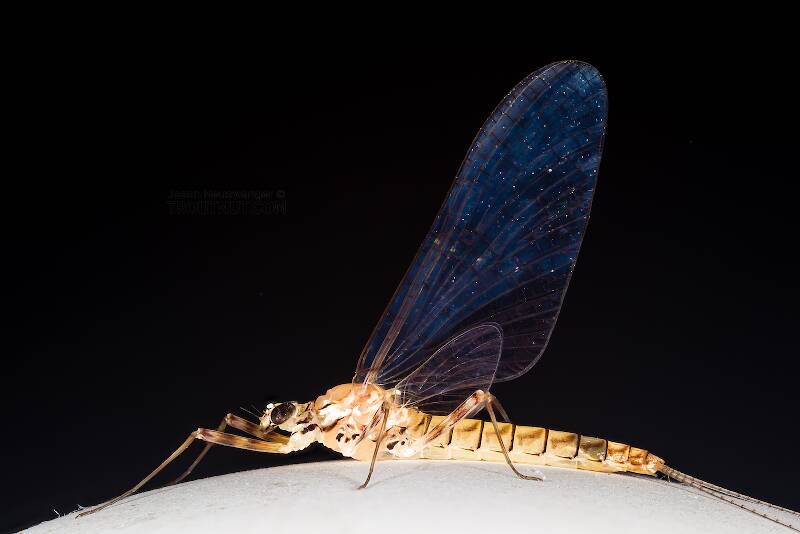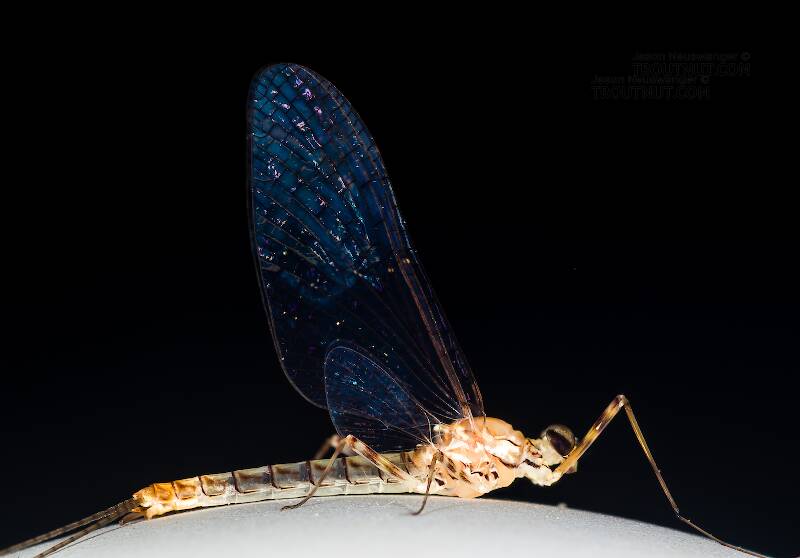
Hex Mayflies
Hexagenia limbata
The famous nocturnal Hex hatch of the Midwest (and a few other lucky locations) stirs to the surface mythically large brown trout that only touch streamers for the rest of the year.

I'm calling this one Pycnopsyche, but it's a bit perplexing. It seems to key definitively to at least Couplet 8 of the Key to Genera of Limnephilidae Larvae. That narrows it down to three genera, and the case seems wrong for the other two. The case looks right for Pycnopsyche, and it fits one of the key characteristics: "Abdominal sternum II without chloride epithelium and abdominal segment IX with only single seta on each side of dorsal sclerite." However, the characteristic "metanotal sa1 sclerites not fused, although often contiguous" does not seem to fit well. Those sclerites sure look fused to me, although I can make out a thin groove in the touching halves in the anterior half under the microscope. Perhaps this is a regional variation.
The only species of Pycnopsyche documented in Washington state is Pycnopsyche guttifera, and the colors and markings around the head of this specimen seem to match very well a specimen of that species from Massachusetts on Bugguide. So I am placing it in that species for now.
Whatever species this is, I photographed another specimen of seemingly the same species from the same spot a couple months later.

Mayfly Species Cinygma dimicki (Western Light Cahills)
Where & when
This species may be locally important in the West. Knopp and Cormier in Mayflies: An Angler's Study of Trout Water Ephemeroptera report that there are dimicki hatches in Yellowstone National Park.In the Seattle area, I found swarms of spinners multiple nights in a row in late June and early July, but they were overshadowed by more abundant other species.
In 2 records from GBIF, adults of this species have been collected during August (100%).
Species Range
Spinner behavior
Time of day: Dusk
Physical description
Most physical descriptions on Troutnut are direct or slightly edited quotes from the original scientific sources describing or updating the species, although there may be errors in copying them to this website. Such descriptions aren't always definitive, because species often turn out to be more variable than the original describers observed. In some cases, only a single specimen was described! However, they are useful starting points.
Male Spinner
Wing length: 11 mm
Head pale yellowish faintly tinged with light brownish on vertex. Pronotum pale ochreous tinged with brownish, each lobe bordered laterally by a black line and with an oblique black median streak; a strong black streak at base of foreleg. Mesonotum pale brownish, lateral edges and scutellum light yellow; pleura pale brownish with a light yellow patch anterior to wing base, this patch bordered both dorsally and ventrally by distinct black streaks; black streaks at bases of both mid and hind legs. Metanotum pale brownish with a paler, more yellowish, median projection. Abdomen with segments I-VII pale hyaline yellowish, each segment with narrow posterior black border and with dark streak on posterior half of lateral edge; last three segments opaque, tinged with light brown. On all but the first and the last two segments there are indistinct, lateral, L-shaped smoky marks with small commalike streaks attached ventrad to the anterior ends of same. Ventrally pale yellowish, the two posterior segments faintly tinged with brownish. Forceps pale smoky; setae deep smoky with fine dark intersegmental rings. Legs dull amber, the tibiae and tarsi tinged with smoky, the femora twice-banded with purple-brown, coxae with a black streak. Wings hyaline with fine dark veins and crossveins.
The male genitalia are quite similar to those of Cinygma integrum, but the stimuli are smaller, and the apex of each lobe of the penes is evenly rounded and without the slight tooth found in integrum, there is also less of a lateral excavation at the junction between the basal and apical sections. Both species show a pair of minute spines dorsally near the base of cach lobe of penes, a feature not shown McDunnough's drawing of Cinygma integrum (1926, Can. Ent. LVIII, 302).
Specimens of the Mayfly Species Cinygma dimicki
2 Male Spinners
1 Female Spinner

Start a Discussion of Cinygma dimicki
References
- Knopp, Malcolm and Robert Cormier. 1997. Mayflies: An Angler's Study of Trout Water Ephemeroptera . The Lyons Press.
- McDunnough, J. 1934. New species of North American Ephemeroptera IV. Canadian Entomologist 66: 154-164.
Mayfly Species Cinygma dimicki (Western Light Cahills)
Species Range
Common Names
Resources
- NatureServe
- Integrated Taxonomic Information System
- Global Biodiversity Information Facility
- Described by McDunnough (1934)



